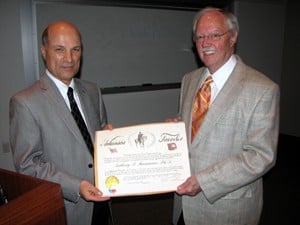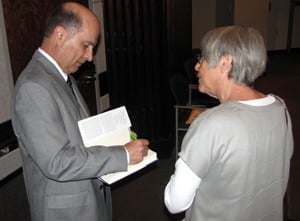Therapy Brings Hope to Traumatized Children, Expert Says
April 27, 2010 | The first goal of mental health treatment is to offer hope to children who have been victims of abuse and their families, according to a national expert on child abuse. “It is important for children and their parents to understand early that recovery occurs. But part of the challenge of treating traumatized children is trying to determine what they need right now,” said Anthony Mannarino, Ph.D., director of the Center for Traumatic Stress in Children and Adolescents at Allegheny General Hospital in Pittsburgh. A former president of the American Professional Society on the Abuse of Children, Mannarino was the main presenter at a two-day conference on trauma-focused cognitive behavioral therapy (TF-CBT) for traumatized children and their families held April 15-16 at the University of Arkansas for Medical Sciences (UAMS). The conference brought in more than 130 mental health professionals, therapists and counselors from across the state who regularly deal with children suffering from mental disorders and their families. The two-day event, provided at no cost, was sponsored by the AR BEST (Arkansas Building Effective Services for Trauma) program, a joint program between the UAMS departments of Psychiatry and Pediatrics. Mannarino, who was named to the U.S. Presidential Task Force on Child and Adolescent Post Traumatic Stress Disorder and Trauma in 2008, co-developed the trauma-focused cognitive behavioral therapy program that has been embraced by treatment centers around the country. He said one of the problems therapists face is the day-to-day situations that threaten long-term success in treating abused children. Many parents prefer to focus on what he called the crisis of the day or the crisis of the week. Dealing with immediate concerns, whether it’s substance abuse, criminal mischief or sexual behaviors, before addressing trauma-related disorders will help ensure long-term success in treating abused children, Mannarino said. Trauma-focused therapy centers on coping skills that allow therapists to help their patients deal with the emotional, physical and psychological effects of trauma and help children process traumatic events with important family members. The treatment plan has shown tremendous success in a variety of settings, including outpatient, residential centers and schools, Mannarino said. It’s also been adapted by counselors to address the needs of Native American and Hispanic patients. “There is some universality to the trauma experience. Our research has shown that the treatment may be appropriate for children around the world.” That the program has been the subject of eight randomized controlled tests, all of which showed similar successful outcomes, is one of the intervention’s chief selling points, Mannarino said. “You want to tell the families with whom you’ll be working that the treatment you’ll be using has been thoroughly researched,” Mannarino told the audience. The best results occur when both the patient and parents are seen by the same therapist. “It offers families hope that what their children are going through has been seen numerous times and treated successfully. And not only children. Parents get better, too.” |

